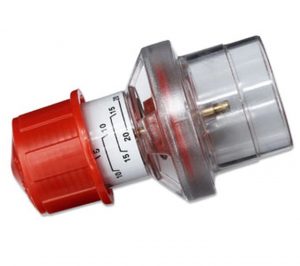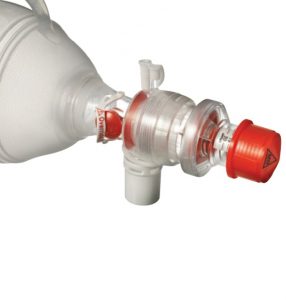On the go? Listen to the article in the player below!
Positive End Expiratory Pressure, or PEEP, is getting a lot of attention lately. First described in 1938 as an addition to mechanical ventilation that improved oxygenation1 in acute pulmonary edema, asphyxia and sepsis, the hemodynamic effects of PEEP prevented its widespread use until the 1960s. By 1970, PEEP had gained traction in treating premature neonates with respiratory distress2 and adults with acute respiratory distress syndrome (ARDS).3 Today, a growing body of literature suggests that PEEP benefits a wide variety of patients with respiratory distress and might well be useful any time you need to assist ventilations.
Simply defined, PEEP is the pressure above atmospheric pressure measured in the alveoli at end expiration. It is one of the first ventilator parameters set and would typically be “dialed in” to between 3 and 5 cmH2O, sometimes referred to as, “physiologic PEEP.”4 This positive, end expiratory, pressure serves to prevent collapse of the alveoli at end expiration as well as to prevent repeated opening and closing of the alveoli, which is thought to cause ventilator-induced lung injuries. PEEP may also serve to recruit already collapsed alveoli, reopening them so they can participate in gas exchange.5 The primary use of PEEP has typically been to improve oxygenation. PEEP can also be applied when using a bag-valve mask by attaching a PEEP valve to the bag and selecting the level of PEEP desired (see illustration). Some bag-valve-masks are manufactured with integral PEEP valves.

PEEP valve. User selects the desired level of PEEP. (Photo courtesy Ambu USA)

PEEP valve in place on bag-valve resuscitator. (Photo courtesy Ambu USA)
CPAP (Continuous Positive Airway Pressure) also improves oxygenation (see: The Miracle of CPAP) and, conceptually, is the same as PEEP except that CPAP applies pressure continuously throughout inspiration and expiration, whereas PEEP pressure is applied only at end expiration. The other hemodynamic effects of CPAP can be seen to a similar degree with PEEP, and these effects can be both helpful as well as harmful.6 The beneficial effects include lowering of left ventricular afterload (as a consequence of decreasing the transmural pressures), leading to lower preload. Conversely, the increased intrathoracic pressure may significantly lower venous return, particularly in patients with fluid volume deficits, leading to hypotension. Overall, it would seem that low levels of PEEP are beneficial, while the ideal level of PEEP likely varies from patient to patient.5
COVID-19 has focused attention on PEEP. The disease process causes significant hypoxia; PEEP has been helpful in improving oxygenation. The number of ventilated COVID patients has resulted in a national shortage of disposable PEEP valves. The increased use of PEEP across the spectrum suggests it has value, hence the current focus on this intervention.
If you use mechanical ventilators, you probably already put some PEEP on every patient. When oxygenation is a problem (i.e., patients requiring more than 0.5 FiO2), additional PEEP will likely help. Any mechanically ventilated patient being maintained with greater than 5 CWP of PEEP should have a PEEP valve on their manual resuscitator so that the recruitment achieved on the vent is not lost when manually ventilating the patient. Do the benefits of PEEP warrant your service purchasing PEEP valves for use on your bag-valve-masks, aside from those used for mechanically ventilated patients? The answer, while largely theoretical, is, probably.
The bottom line on PEEP is that it increases airway pressure. This improves alveolar recruitment (or the total number of alveoli open and participating in gas exchange) and improves oxygenation. PEEP also increases the functional residual capacity (FRC), a value you learned about in anatomy and physiology class a long time ago, which prevents alveoli from collapsing in between breaths. It is very likely that use of PEEP reduces the incidence of ventilator induced lung injury by keeping more alveoli open, thereby preventing mechanical trauma from repeated collapse and reopening. PEEP also shifts lung water from the alveoli to the perivascular interstitial spaces and, while not reducing total lung water, it greatly increases lung surface area available for ventilation.1-7 PEEP also significantly decreases the work of breathing, whether on a mechanical ventilator or during bag-valve-mask assisted ventilations.7 This provides significant improvement in patient comfort.
PEEP is a tool available to any EMS provider, even at the BLS level, to improve oxygenation, decrease the work of breathing, offer favorable changes in hemodynamics, and quite likely, improve patient outcomes. Use of PEEP should be considered for any patient who requires mechanical ventilation, including those in cardiac arrest. Evidence suggests that PEEP offers some significant benefits to our sickest patients.
References
- Barach AL, Martin J, Eckman M. Positive pressure respiration and its application to the treatment of acute pulmonary edema. Ann Intern Med 1938;12:754-95.
- Gregory GA, Kitterman JA, Phibbs RH, Tooley WH, Hamilton WK. Treatment of the idiopathic respiratory-distress syndrome with continuous positive airway pressure. N Engl J Med. 1971;284(24):1333-1340.
- Falke KJ, Pontoppidan H, Kumar A, Leith DE, Geffin B, Laver MB. Ventilation with end-expiratory pressure in acute lung disease. J Clin Invest. 1972;51(9):2315-2323.
- Smith, RA. Physiologic PEEP. Respir Care 1988; 33:620.
- Costa Leme A, Hajjar LA, Volpe MS, et al. Effect of Intensive vs Moderate Alveolar Recruitment Strategies Added to Lung-Protective Ventilation on Postoperative Pulmonary Complications: A Randomized Clinical Trial. JAMA 2017; 317:1422.
- Dhainaut JF, Devaux JY, Monsallier JF, et al. Mechanisms of decreased left ventricular preload during continuous positive pressure ventilation in ARDS. Chest. 1986;90:74-80.
- Fan E, Del Sorbo L, Goligher EC, et al. An Official American Thoracic Society/European Society of Intensive Care Medicine/Society of Critical Care Medicine Clinical Practice Guideline: Mechanical Ventilation in Adult Patients with Acute Respiratory Distress Syndrome [published correction appears in Am J Respir Crit Care Med. 2017 Jun 1;195(11):1540]. Am J Respir Crit Care Med. 2017;195:1253‐1263.
Mike McEvoy, PhD, NRP, RN, CCRN, is the EMS coordinator for Saratoga County, New York, and the professional development coordinator for Clifton Park and Halfmoon Ambulance. He is a nurse clinician in the adult and pediatric cardiac surgery intensive care units at Albany Medical Center, where he also teaches critical care medicine. McEvoy is the chief medical officer and firefighter/paramedic for West Crescent Fire Department in Clifton, New York. He is also the chair of the EMS Section board of directors for the International Association of Fire Chiefs and a member of the New York State Governor’s EMS Advisory Council. He is a lead author of the textbook Critical Care Transport, the “Informed” Pocket References (Jones & Bartlett), and the American Academy of Pediatrics textbook Pediatric Education for Prehospital Professionals (PEPP).


